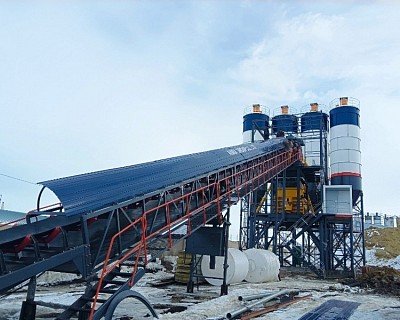Ready Mix Concrete Batch Plant
Global Trends Shaping the Ready Mix Concrete Batch Plant Industry in 2025
As urbanization and infrastructure development continue to surge globally, the demand for high-quality and efficient concrete production is rising. Among the key technologies facilitating this growth is the ready mix concrete batch plant. In 2025, the global ready mix concrete industry is expected to witness major shifts driven by technology, sustainability goals, automation, and regional development dynamics. This article explores the top global trends shaping the ready mix concrete batch plant sector, with a particular spotlight on the growing market for the ready mix concrete plant in Bangladesh.
1. Rising Demand for Urban Infrastructure
Urbanization remains a primary driver for the growth of ready mix concrete batch plants. As cities expand, the need for rapid, reliable, and quality concrete production increases. Infrastructure projects such as highways, bridges, commercial complexes, and smart city initiatives are demanding more efficient construction solutions. This trend is particularly strong in emerging economies across Asia, Africa, and Latin America.
2. Surge in Prefabricated and Modular Construction
The move toward prefabricated buildings and modular construction is influencing the configuration and capacity of ready mix concrete batch plants. Plants now need to deliver consistent mix designs with minimal downtime and strict quality control. Batch plants are being tailored for high-precision operations, often with automated systems to match the speed and precision required by off-site construction methods.
3. Technological Advancements and Automation
Technology continues to redefine plant operations. In 2025, modern batch plants are equipped with:
AI-powered control systems for optimal mix ratios and real-time decision-making
IoT sensors for monitoring material levels, temperature, humidity, and machine health
Cloud-based monitoring systems that provide remote access and predictive analytics
These innovations increase plant productivity, reduce operational errors, and cut down on labor costs, making them highly attractive to both small and large construction firms.
4. Environmental and Regulatory Pressures
Sustainability has become a global mandate. Governments and environmental agencies are enforcing stricter regulations on construction emissions, waste, and material usage. As a result, ready mix concrete batch plants are adopting eco-friendly practices such as:
Recycling concrete waste and water
Using alternative binders and low-carbon cement
Integrating dust collection and noise reduction systems
Green-certified batch plants are gaining popularity, especially among government contractors and urban developers focused on sustainable construction.
5. Mobile and Compact Plant Solutions
The increasing need for flexibility on construction sites has spurred the demand for mobile ready mix concrete batch plants. These plants are easy to transport, quick to install, and ideal for short-term or remote projects. Compact stationary models are also gaining traction in urban settings where space is limited.
6. Regional Spotlight: Ready Mix Concrete Plant in Bangladesh
Bangladesh is emerging as a dynamic market for the concrete industry, driven by major government infrastructure projects such as the Padma Bridge, Dhaka Metro Rail, and various highway expansions. The demand for ready mix concrete plant in Bangladesh is rising steadily as contractors look for faster and more consistent concrete solutions.
In cities like Dhaka, Chittagong, and Khulna, the use of ready mix concrete has become the norm for both public and private sector projects. International and local suppliers are actively investing in advanced batch plant technologies to cater to the unique requirements of the region—such as high humidity, fluctuating temperatures, and logistical challenges.
Additionally, the Bangladesh government’s focus on sustainable construction is creating opportunities for eco-friendly and automated batching plant systems. The cost-effectiveness of ready mix concrete, combined with quality assurance and time efficiency, is making it the preferred choice across sectors.
7. Shift Toward Digital Integration
Plant operators are increasingly embracing digital transformation. In 2025, many batch plants will be part of a larger digital construction ecosystem, integrating with:
ERP and supply chain software
Building Information Modeling (BIM) platforms
Fleet management systems
This interconnectedness enables greater transparency, streamlined logistics, and enhanced quality assurance across the entire project lifecycle.
8. Workforce Upskilling and Safety Improvements
As automation becomes more widespread, the need for a tech-savvy workforce grows. Companies are investing in training programs for plant operators, engineers, and maintenance staff to ensure smooth adoption of new technologies. Safety features such as automated shut-offs, real-time hazard alerts, and remote control capabilities are also being integrated into modern batching systems.
9. Competitive Landscape and Strategic Partnerships
Global and regional players are entering strategic alliances to tap into new markets. Equipment manufacturers are partnering with construction companies, tech firms, and local distributors to provide integrated solutions. The ready mix concrete batch plant market is seeing increased competition, driving innovation and better service delivery.
Conclusion
The global ready mix concrete batch plant industry in 2025 is poised for accelerated growth, shaped by technological innovations, sustainability goals, and evolving market demands. For regions like Bangladesh, the integration of smart batching solutions will be key to meeting infrastructure needs efficiently. As the industry continues to evolve, companies that invest in digital capabilities, environmental compliance, and flexible plant solutions will lead the way in this competitive and fast-paced market.

